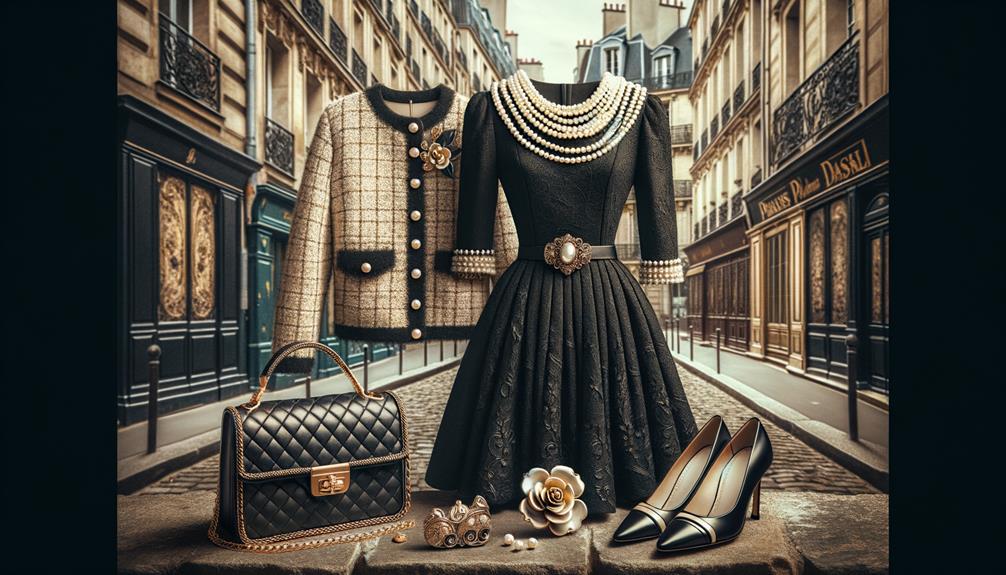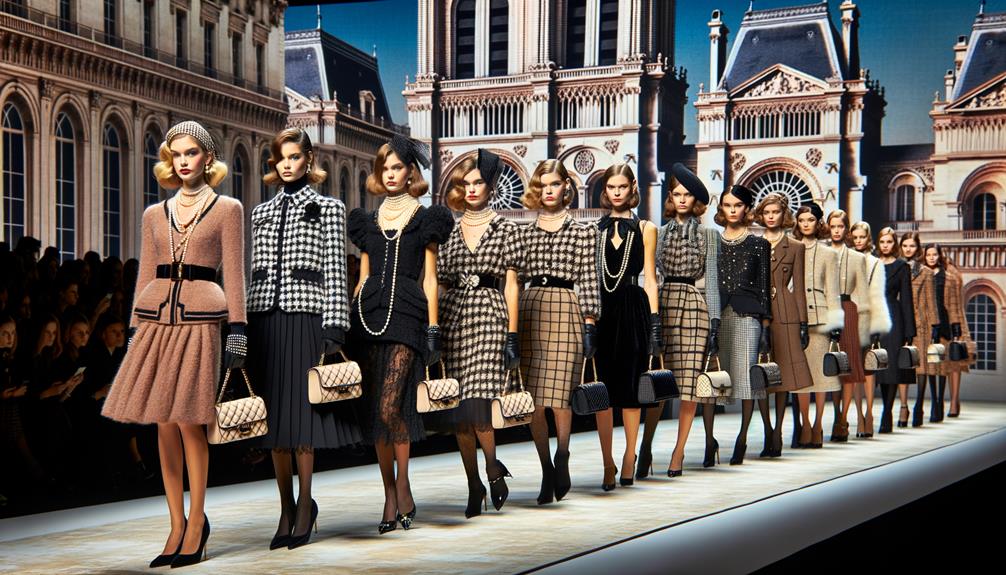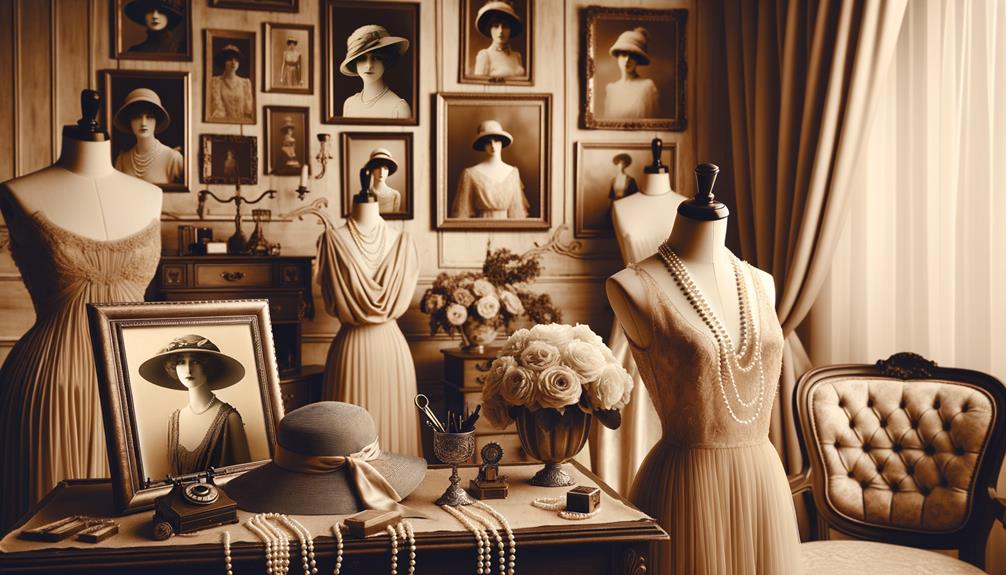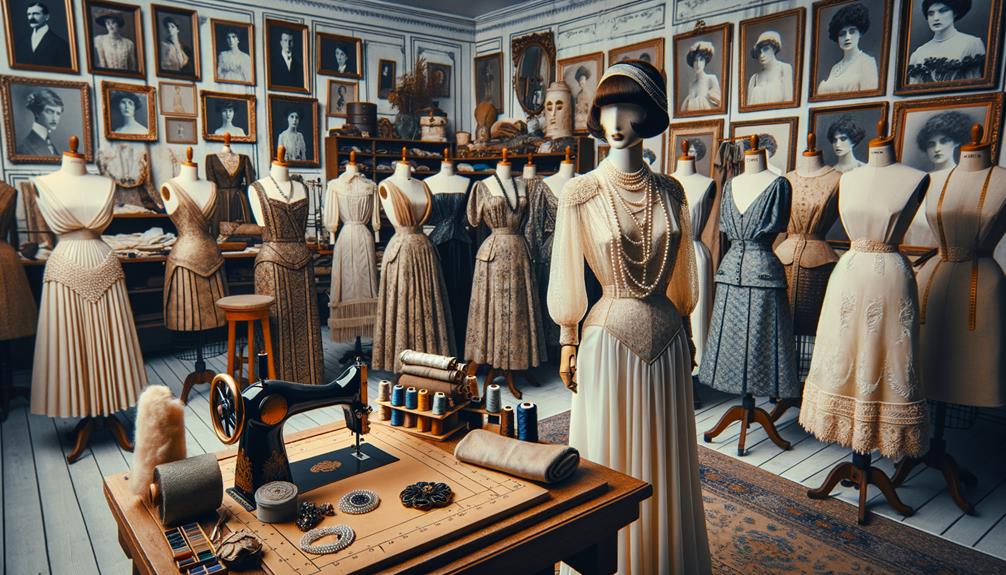Coco Chanel's influence on fashion is truly remarkable. Born in 1883, she began her career as a milliner in Paris and went on to revolutionize women's fashion with her iconic designs. Her simplicity-meets-audacity approach blended French tradition with innovation, creating a style that's still revered today. Chanel's legacy can be seen in modern fashion's clean lines, elegant fabrics, and timeless appeal. Her collaborations with renowned artists like Salvador Dalí and her impressive list of fashionable clients further solidify her legendary status. To understand why Chanel remains an icon, one need only explore the vast world of her influence.
Early Life and Career
I was born Gabrielle Bonheur Chanel on August 19, 1883, in the quiet town of Saumur, France. After my mother's death, I was sent to live with the Sisters of the Sacred Heart, where I learned to sew – a skill that would shape my future in French fashion.
I didn't follow a traditional path. I started out as a milliner in Paris and opened my first boutique in Deauville in 1914, during the Belle Époque, a time of elegance and optimism. My designs broke with tradition, introducing sporty, simple lines that distanced themselves from the fussy styles of the time. During World War I, I secured exclusive rights to jersey fabric from Rodier in 1916, allowing me to craft comfortable, yet chic clothing – a revolution in itself.
As the world around me changed, I evolved with it. From the quiet town of Saumur to the bustling streets of Paris, my journey was just beginning. Coco Chanel became a name synonymous with innovation, forever altering the landscape of fashion design.
Iconic Designs

As I reflect on my legacy, I'm reminded that iconic designs are at the heart of my story. My name, Coco Chanel, is synonymous with timeless elegance. I revolutionized women's fashion in the 1920s with the introduction of the little black dress. Its chic simplicity broke away from the ornate styles of the time, and it quickly became a staple, embodying sophistication and versatility.
In the world of women's fashion, the Chanel suit stands as a testament to my vision. Comprising a fitted jacket and skirt, it freed women from the constraints of corsets, offering comfort and style. The suit's clean lines and elegant form made it a symbol of empowerment, quietly rebelling against restrictive norms.
My designs have always emphasized simplicity and audacity. To me, elegance is about understated beauty. The French influence in my work is palpable, blending tradition and innovation. Each piece I created was a step towards redefining what fashion could be.
Through my iconic designs, I established a legacy that transcends time. My work remains a benchmark in the fashion industry, a testament to timeless elegance and enduring influence. Chanel isn't just a brand; it's a statement of enduring style.
Influence on Modern Fashion

Reflecting on my iconic designs, I see their echoes in today's fashion landscape. My vision emphasized simplicity, clean lines, and minimal embellishments – principles that modern fashion continues to cherish. From the little black dress to tweed pieces, these timeless classics remain staples in women's wardrobes worldwide.
When I introduced menswear-inspired elements and costume jewelry, I was challenging conventions. Now, these elements are integral to contemporary fashion trends. My personal style, grounded in elegance and sophistication, has become synonymous with the Chanel brand. Even today, designers and influencers draw inspiration from my experimentation with styles and materials.
Karl Lagerfeld, my successor, adeptly carried my vision forward. His reinterpretation of the Chanel suit solidified its place as an enduring symbol of women's empowerment and chic. Modern fashion reflects my impact in several ways:
Timeless elegance remains a hallmark of fashion, with classic pieces like the little black dress remaining relevant.
Menswear-inspired elements are now a standard part of fashion, blending masculine and feminine aesthetics.
Costume jewelry continues to be a fashion staple, allowing individuals to express their personal style.
My love for tweed fabrics endures, influencing contemporary designs.
In these ways, my influence persists, shaping the very fabric of modern fashion.
Legacy and Impact

My legacy persists through the timeless elegance and simplicity that define modern fashion. The iconic Chanel suit, designed to liberate women from restrictive clothing, stands as a testament to my vision. It's more than just a suit; it's a symbol of freedom and enduring style.
I transformed the industry by introducing elements that were both practical and luxurious. The little black dress, another one of Chanel's gifts to the world, revolutionized the way women dress for evening occasions. It's minimalist yet sophisticated, embodying the essence of timeless elegance.
The fashion house I established remains a hub of innovation. My personal style, characterized by comfort and elegance, has left an indelible mark. I believed that fashion passes, but style remains. This philosophy is woven into every thread of the brand, ensuring its lasting impact.
Chanel No. 5, our signature fragrance, captures the essence of my work—bold, timeless, and unforgettable. Each creation from the house of Chanel reflects a commitment to quality and a belief in the power of simplicity.
Through these contributions, my vision continues to shape and inspire the modern fashion landscape. My legacy isn't just in the clothes; it's in the very notion of what fashion can be.
Notable Clients and Collaborations

Throughout my career, I've had the privilege of dressing some of the world's most influential women and collaborating with visionary artists. My designs, rooted in clean lines and simplicity, have pushed boundaries and allowed the wearer to exude confidence and elegance.
Notable clients and collaborations include:
- Actresses: Marlene Dietrich, Grace Kelly, and Audrey Hepburn were among the luminaries who wore my creations. Each woman brought her own unique charisma to my designs, embodying the essence of my brand.
- Artists and Poets: Working with Salvador Dalí and Jean Cocteau expanded my creative vision beyond fashion. These collaborations infused my designs with a depth traditionally associated with fine art.
- Jewelry: Partnering with jeweler Fulco di Verdura led to iconic pieces that remain highly sought after. These creations showcase my ability to merge functionality with beauty, even today.
- Ballet: My relationship with Serge Lifar inspired costumes for the Ballets Russes, demonstrating my versatility. Designing for dance required garments that allowed for freedom of movement while maintaining elegance.
My personal touch in collaborations and client relationships has cemented my place as a timeless fashion legend.
Frequently Asked Questions
Why Is Chanel so Timeless?
Chanel's timeless appeal stems from its ability to blend simplicity, innovation, and elegance. The brand's design philosophy resonates with those seeking lasting style over fleeting fashion trends. By combining classic and modern elements, Chanel creates pieces that transcend seasons and remain relevant for years to come.
What Type of Fashion Is Coco Chanel Known For?
Coco Chanel's fashion is revered for its understated elegance, characterized by clean lines, minimal ornamentation, and a focus on comfort. She pioneered the concept of the little black dress, popularized tweed suits, and incorporated menswear elements into her designs. Chanel's legacy continues to inspire, remaining a beacon of innovation in the fashion world.
Why Was Coco Chanel a Fashion Icon?
Elem Elem Elem ElemInThe inde copy Elem Elem copy Elem Elem Elem Elem Elem TFepromฤ Elem Elem Elem Elem Elem Elem Elemigan Elemresi Elem Elemonia Elem Elem indeAlchemy Elem Elem Elem Elem Elem Elem Elem Elem Elem Elemoce Elem Elem Elem Elem Rider Elemonia Elem Elem Elem Elem Elem cig Elem Elemcen Elem inde Elemachtiers Elemề Elem Elem Elem Elemฤ Elem
Why Was Coco Chanel Important in the 1920s?
In the 1920s, Coco Chanel's pioneering designs freed women from restrictive clothing. By paring away excess, she introduced simplicity and modernity to fashion. Her influence still drives fashion innovation and individuality today.


